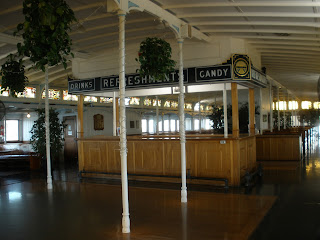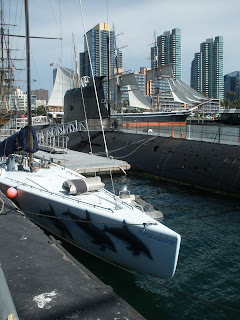By: Andrew Bermudez
We only have three more parts to finish up this account of our San Diego vacation! Let's get started!
By the time we had left the Marine Corps Recruit Depot Command Museum, the heat had reached sweltering conditions. But we weren't worried, because our next stop was the Maritime Museum of San Diego.
 |
| An overview of the Maritime Museum, as seen from the deck of the Star of India. |
The one thing about this museum that makes it different from others is that it is entirely free-floating; only anchors hold it in place. The museum acts as a collage of several sailing vessels from different time periods and countries. To get a general idea of the variety of ships and submarines on exhibit, here is a run-down of the ships on display.
Berkeley Ferryboat: Serving as the entrance to the museum, the Berkeley impresses with its Victorian-era furnishings and stained glass windows. The first steel-hulled, double-ended, propeller-driven ferryboat in San Francisco Bay, it served as a means of evacuating the city during the 1906 San Francisco Earthquake. It also ferried travelers between the Oakland transcontinental railroad terminus and San Francisco. This vessel also houses the museum's gift shop and restaurant, along with exhibits on San Diego's maritime history. It proves to be a strong start to the museum visit.
HMS Surprise: Known for its appearances in films such as Master and Commander: The Far Side of the World and Pirates of the Caribbean: Curse of the Black Pearl, the HMS Surprise is a replica of the British sailing vessel HMS Rose, built as a sail training tall ship. It contains entirely authentic and accurate details, including sleeping quarters, helm, storage, captain's quarters, and cannons (as if we hadn't seen enough of those back in '09, but I digress). It is a really authentic experience that gives you the idea of what it feels like to live on such a vessel.
B-39: This entirely authentic Soviet submarine puts you in the middle of Cold War naval combat, keeping an eye on the enemy. Well...it's not actually a simulator or anything like that, but it does give you an idea of what it was like to live on a combat submarine. Then you have to remember: people lived in this for months at a time. I don't know about you, but staying on a submarine like this that isn't as well-built as other submarines (like the USS Dolphin, which I'll get to in a little bit) for that long really gives me a sinking feeling (*GROAN*). Be warned, though. This experience is not for everyone. If you cannot fit through the test porthole (an actual porthole on the sub can be partially seen in the second picture) or have problems with small spaces, this experience is not recommended for you. Otherwise, this is a must.
Star of India: Widely considered the main attraction of the maritime museum, the Star of India is the oldest active merchant ship in the world. Built in 1863, the ship served as a cargo ship to transport cotton from India to England, hence its name. At the museum, the ship takes guests back in time to the age of the sail with exhibits on the ship's history and artifacts. It also serves as the special exhibit hall (the exhibit on display was a collection of photographs from Jack London's travels) and special event hall. Just as its name suggests, this vessel truly is a star. Make it part of your visit.
However, it is in the last function for events where I must say is the museum's only shortcoming. You see, when the museum hosts birthday parties, they are done inside the hull of the star of India. However, possibly as a way to make the prospect of parties more appealing to 10-year-old boys, an extremely tacky mini pirate ship has been set up for kids to play in (pictured in the second photo). I know boys love pirates, but was this really necessary? It just garishly contrasts with the rest of the ship. Oh, well. I guess this also explains the abundance of pirate merchandise in the gift shop, despite the lack of an actual pirate ship at the museum.
Abracadabra, America, and Stars & Stripes: At the rear of the museum is a floating dock, where several smaller ships are on display. Three of these ships are the Abracadabra, America, and Stars & Stripes. They are called "America's cup boats," according to the museum map, and line either side of the floating dock. They do not play any major role at the museum (except for the Stars & Stripes, which can be rented by calling the number on the map), but they are nonetheless a nice touch.
 |
| A whole slew of cannons is parked next to the Californian. |
Californian: This is California's official tall ship. Modeled after revenue cutters of the late 1840's, known for patrolling the coast of California in the gold rush days, the ship features four six-pound deck guns and exhibits to explore the role the ship played during the California Gold Rush.
Medea: Built as a gentleman's hunting yacht in 1904, the Medea impresses with its Victorian-era design, complete with lounge and other luxurious details. The details are amazing, even if guest access is pretty restricted. This is probably because, despite its age, the ship is still active.
Pilot: Hosting $3 harbor tours daily, the Pilot is the oldest wooden pilot boat in the country. Until the 1980's, the Pilot was San Diego's main pilot boat and, according to the map, occasionally still transports pilots to and from historic ships. Because it is used for the harbor tours, only tour groups may board this vessel.
USS Dolphin: Holding the operating submarine depth record, the USS Dolphin is a US naval research submarine also holds the record for deepest torpedo launch and sent and received the first underwater email. Far more spacious and better built than the B-39, the USS Dolphin is a good alternative for those who were unable to experience the B-39.
And with that, the Maritime Museum of San Diego is finished. Granted, its admission price of $15 a person seems a little steep, but the experience is worth it. It is unlike anything else I've experienced. After leaving the museum, we headed downtown for dinner at a very unique restaurant.
Next Time: San Diego Waterfront and Kansas City Barbecue.











